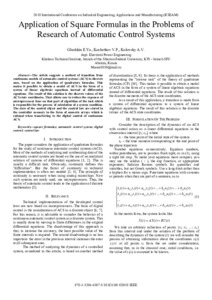Application of square formulas in the problems of research of automatic control systems
Скачать файл:
URI (для ссылок/цитирований):
https://ieeexplore.ieee.org/document/8728705https://elib.sfu-kras.ru/handle/2311/128566
Автор:
Glushkin, E. Y.
Kochetkov, V. P.
Kolovsky, A. V.
Коллективный автор:
Хакасский технический институт — филиал СФУ
Кафедра электроэнергетики
Дата:
2018-05Журнал:
2018 International Conference on Industrial Engineering, Applications and Manufacturing, ICIEAM 2018Квартиль журнала в Scopus:
без квартиляКвартиль журнала в Web of Science:
без квартиляБиблиографическое описание:
Glushkin, E. Y. Application of square formulas in the problems of research of automatic control systems [Текст] / E. Y. Glushkin, V. P. Kochetkov, A. V. Kolovsky // 2018 International Conference on Industrial Engineering, Applications and Manufacturing, ICIEAM 2018. — 2018.Текст статьи не публикуется в открытом доступе в соответствии с политикой журнала.
Аннотация:
The article suggests a method of transition from
continuous models of automatic control systems (ACS) to discrete
ones, based on the application of quadrature formulas. This
makes it possible to obtain a model of ACS in the form of a
system of linear algebraic equations instead of differential
equations. The result of this solution is the discrete values of the
ACS state coordinates. That allows one to reduce the expenses of
microprocessor time on that part of algorithm of the task which
is responsible for the process of calculation of a system condition.
The state of the control object and the control law are stored in
the controller memory in the form of numeric arrays which is
rational when transferring to the digital control of continuous
ACS.
Коллекции:
Метаданные:
Показать полную информациюСвязанные материалы
Показаны похожие ресурсы по названию, автору или тематике.
-
Combined control of aluminum bath composition by X-ray diffraction and X-ray fluorescence analysis: Combined control of aluminum bath by XRD and XRF analysis
Oksana, Piksina; Eugene, Andruschenko; Petr, Dubinin; Sergei, Kirik; Sergey, Ruzhnikov; Alexandr, Samoilo; Igor, Yakimov; Aleksandr, Zaloga (2017-04)The present paper provides a combined application of X‐ray diffraction (XRD) and X‐ray fluorescence (XRF) methods in process control for the analysis of aluminum baths of different compositions. Developed approaches to the ... -
Double Loop Control of Linear Dynamical Systems and an Algorithm for Adjustment of the Typical Controllers Using the Nonparametric Model of a Llinear Dynamical System
Alexander, Nikolaevich Pupkov; Roman, Yurievich Tsarev (2017-10)The paper considers the double loop control of a linear dynamic system based on a nonparametric model. The process of constructing a controller is presented. At the first stage, the nonparametric model of a macro-object ... -
Parametric Synthesis Method of PID Controllers for High-Order Control Systems
Prokopev, A.; Nabizhanov, Z.; Ivanchura, V.; Emelyanov, R. (2020) -
Self-Control and Subjective Volitional Regulation as Personal Predictors of High School Students Success in the Framework of Career-Oriented Education in High School
Dementiy, Ludmila I.; Kupchenko, Victoria E.; Дементий, Л.И.; Купченко, В.Е. (Сибирский федеральный университет. Siberian Federal University., 2014-12)The article provides a theoretical overview of research reflecting correlation between intellectual factors, motivational and personality variables with high school students’ academic performance. This empirical research ... -
Control Conductance of Single Walled Carbon Nanotubes Films During Synthesis
Bryantsev, Yaroslav A.; Arhipov, Viacheslav E.; Romanenko, Anatoly I.; Berdinsky, Alexander S.; Okotrub, Alexander V.; Брянцев, Ярослав А.; Архипов, Вячеслав Е.; Романенко, Анатолий И.; Бердинский, Александр С.; Окотруб, Александр В. (Сибирский федеральный университет. Siberian Federal University, 2018-06)We investigated electrical conductance of single-walled carbon nanotubes (SWCNTs) films during the time of synthesis. The time dependence of conductance have been described in terms of the Shklovsky - de Gennes percolation ...

